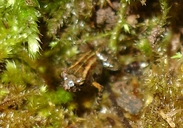|
Sooglossus thomasseti (Boulenger, 1909)
| family: Sooglossidae genus: Sooglossus |
 © 2010 Dr. Justin Gerlach (1 of 1) |
|
|
|
Description Sooglossus thomasseti is distinct from other Sooglossus species due to the fact it has vomerine teeth and that it does not have claw-like, dermal tips on the digits (Boulenger 1909). It is also significantly larger than the similar Sooglossus sechellensis. Recently, Nussbaum and Wu (2007) have identified fifteen unique derived characters of this species. They are: fleshy discs at the tips of toes and fingers, the muscle of the tensor fascia latae originating on the posterior 1/3 of the ilium, a crest on the posterior half of the frontoparietal, a 45 degree or greater angle between the horizontal process of squamosal and prootic, the squamosal leans posteroventrally, the prevomer dentary processes are posterior to the choana and do not contact medially, presences of prevomerine teeth, the prevomer and palatine fused, a deep hyoglossal sinus of the hyoid, bifurcated posterolateral process of the hyoid, the length of the transverse process III is shorter than IV, the procoracoid is reduced along the lateral edge, and there is a distal expansion of the omosternum. In life, the dorsal surface of S. thomasseti ranges from reddish-brown to golden. In some individuals there is a broad, brown mid-dorsal stripe. Legs and toes are banded with black bands lines and a thin yellow or white line travels dorsally down the back and along the back of the thighs. Most of the individuals have a white line that extends from behind the eyes backwards to just above the forelimbs. There are two rows of 2 - 6 lightly colored dots running down the back. The eyes are golden with black pupils. The ventral side of the frog is lightly mottled on a brown background (Nussbaum and Wu 2007). The middorsal strip, the thin white or yellow line down the back and across the thighs, and the white line that runs from the eyes to the forelimbs are all variations (Nussbaum and Wu 2007). Distribution and Habitat Country distribution from AmphibiaWeb's database: Seychelles
Life History, Abundance, Activity, and Special Behaviors Call notes are produced at a slower rate than S. sechellensis, making the call longer. The first gutteral note is repeated more than once, normally 3 - 4 times and the call sounds like, "rraackrraack- rraack-toc-toc-toc-toc” (Nussbaum and Wu 2007). The exact mode of development and parental care level is unknown. However, it is thought to have direct terrestrial development based on the large yolky eggs, typical of direct developers. Eggs are large and unpigmented. No larvae have been identified as S. thomasseti, but if present would most likely be found in streams or small ponds, as in S. sechellensis and Sechellophryne gardineri. Based on similar species it is also assumed that female egg-guarding is present in this species. (Nussbaum and Wu 2007). Trends and Threats Possible reasons for amphibian decline General habitat alteration and loss Comments Sooglossus thomasseti was named after Mr. H. P. Thomasset, who was the collector of the holotype specimen in 1905 (Nussbaum and Wu 2007). Sooglossus thomasseti was recently placed within Sooglossus, from Nesomantis, thus making it synonymous with Nesomantis thomasseti. It is sister to Sooglosssus sechellensis. That clade is sister to Sechellophryne gardineri. The Sooglossus genus is monophyletic (Nussbaum and Wu 2007).
References
Boulenger GA. 1909. A list of the freshwater fishes, batrachians, and reptiles obtained by Mr. J. Stanley Gardiners expedition to the Indian Ocean. Trans. Linn. Soc. Lond. 12:291-300. Gerlach J. 2007. Distribution and status of the Seychelles frogs (Amphibia: Anura: Sooglossidae). The Herpetological Journal, 17(2):115-122. Gerlach, J. 2011. The potential effects of climate change on the status of Seychelles frogs (Anura: Sooglossidae). Journal of Threatened Taxa 3(11):2153–2166. Nussbaum, R. A., Gerlach, J. (2004.) Sooglossus thomasseti. In: IUCN 2012. IUCN Red List of Threatened Species. Version 2012.2. www.iucnredlist.org. Downloaded on 24 June 2013. Nussbaum, R. A., Wu S.H. 2007. Morphological Assessments and Phylogenetic Relationships of the Seychellean Frogs of the Family Sooglossidae (Amphibia: Anura). Zoological Studies 46(3): 322-335. Originally submitted by: Sarah Tulga and Ann T. Chang (first posted 2013-07-15) Edited by: Ann T. Chang (2013-07-22) Species Account Citation: AmphibiaWeb 2013 Sooglossus thomasseti <https://amphibiaweb.org/species/5213> University of California, Berkeley, CA, USA. Accessed May 29, 2025.
Feedback or comments about this page.
Citation: AmphibiaWeb. 2025. <https://amphibiaweb.org> University of California, Berkeley, CA, USA. Accessed 29 May 2025. AmphibiaWeb's policy on data use. |




 Map of Life
Map of Life